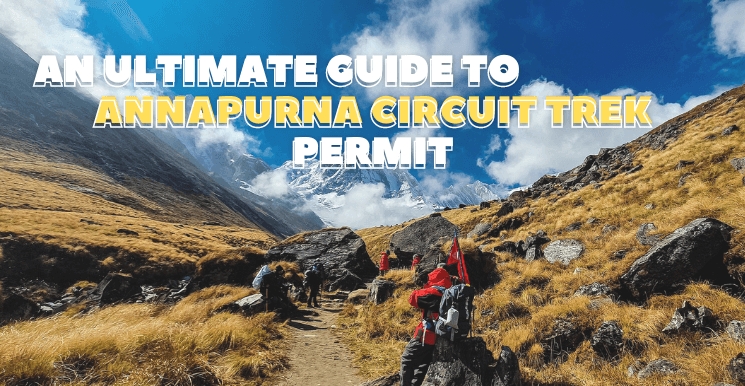- +9779851087405 24/7 Phone Support
- query@adventurehighpass.comEmail Support
Annapurna Circuit Trek Permit: An Ultimate Guide for Trekking Enthusiasts

July 03, 2023, Post by: Adventure High Pass
If you're looking for an adventure in the middle of stunning scenery, the Annapurna Circuit Trek is unlike any other. This trek in Nepal's Annapurna region offers an exciting adventure across diverse terrain, lovely communities, and awe-inspiring mountain panoramas.
To ensure an efficient and memorable trip, it's critical to grasp the Annapurna Circuit Trek permit requirements, regulations, and other essential details. This knowledge is necessary before embarking on this epic trek.
In this article, we'll walk you through the process of obtaining the appropriate permits. Additionally, we'll address frequently asked concerns to help you prepare for your Annapurna Circuit Trek.
Annapurna Circuit Trek Permit
Trekkers must get special permits to visit the Annapurna Circuit. The permits serve two purposes: conservation of the natural environment and safety monitoring of trekkers. The following permits are necessary for the Annapurna Circuit Trek:
Annapurna Conservation Area Permit (ACAP)
The Annapurna Conservation Area Permit (ACAP) is required to enter and trek within the Annapurna Conservation Area. The Nepal Tourism Board issues the ACAP, which is valid for a set period of time. The revenue these permits earn is used to support conservation and long-term development in the region.
You can apply for the ACAP in person at the Nepal Tourism Board headquarters in Kathmandu or Pokhara or have your trekking agency arrange it for you. For foreign nationals, the cost is USD 30, while for SAARC nationals is NPR 200. Furthermore, there is no price for children under the age of ten.
Trekkers' Information Management System (TIMS) Card
Another important document necessary for the Annapurna Circuit Trek is the Trekkers' Information Management System (TIMS) card. It is intended to safeguard trekkers' safety and security by keeping track of their movements within the hiking area.
You can obtain the TIMS card from the Trekking Agencies' Association of Nepal (TAAN) or authorized trekking agencies. There are two kinds of TIMS cards: the green card for Free Individual Trekkers (FITs) and the blue card for guided trekkers.
A TIMS card costs USD 20 per person for Free Individual Trekkers (FITs). The charge is USD 10 per person for trekkers traveling with a licensed trekking agency. SAARC nationals can also receive the TIMS card for NPR 600.
Frequently Asked Questions (FAQs)
1. Is a permit required to trek the Annapurna Circuit?
Yes, you must obtain two permits for trekking the Annapurna Circuit: the Annapurna Conservation Area Permit (ACAP) and the Trekkers' Information Management System (TIMS) card. These permissions are required and protect your safety as well as the natural environment.
2. How can I obtain Annapurna Circuit Trek permits?
Permits can be obtained personally at the Nepal Tourism Board offices in Kathmandu or Pokhara or through authorized trekking companies. You should engage with a trekking agency to ensure a smooth permit acquisition process.
3. What is the cost of the Annapurna Circuit Trek permits?
For foreign nationals, the Annapurna Conservation Area Permit (ACAP) costs USD 30 and NPR 200 for SAARC nationals. Trekkers' Information Management System (TIMS) cards are $20 for Free Individual Trekkers (FITs) and $10 for trekkers travelling with a certified trekking agency. For NPR 600, SAARC nationals can receive a TIMS card.
4. Are there any rules or regulations to follow while trekking the Annapurna Circuit?
Yes, there are several rules you must follow while trekking the Annapurna Circuit. Here are a few examples:
- Limit yourself to established trekking trails and stay out of restricted regions.
- Appreciate the local culture, traditions, and customs.
- Always bring your permits with you and submit them when authorities ask.
- Follow waste management guidelines and avoid littering.
- Get travel insurance that covers high-altitude trekking.
- Acclimate to the increasing altitude and be cautious of altitude sickness symptoms.
- For your safety and convenience, hire a licensed guide or porter.
5. How long does the Annapurna Circuit Trek take to complete?
The Annapurna Circuit Trek time varies depending on elements such as trekking pace, side visits, and acclimatization stops. The entire circuit takes an average of 14 to 18 days to complete. The itinerary, however, can be adjusted to your interests and physical level.
6. What are the Annapurna Circuit Trek's highlights?
The Annapurna Circuit Trek is popular for its jaw-dropping scenery and cultural experiences. Here are some of the trek's highlights:
- Traverse Thorong La Pass, at an elevation of 5,416 meters.
- Discover Manang and Kagbeni's lovely villages.
- Panoramas of the Annapurna Massif, Dhaulagiri, Machhapuchhre (Fishtail), and other spectacular peaks.
- Pay a visit to the holy Muktinath Temple.
- Witness a variety of plants and fauna in the Annapurna Conservation Area.
- Enjoy the friendly welcome of the locals.
Final Say
Getting the proper permits is essential to planning for the Annapurna Circuit Trek. The Annapurna Conservation Area Permit (ACAP) and Trekkers' Information Management System (TIMS) card protect the pristine ecosystem while also ensuring hikers' safety.
You can begin a memorable trip across the mesmerizing vistas of the Annapurna region by following the regulations, respecting the local culture, and being well-prepared.
So, gather your stuff, obtain your permits, and prepare to embark on an experience of a lifetime on the Annapurna Circuit. Trekking through high mountains, beautiful woods, and friendly villages will definitely leave you with fond memories and a strong respect for nature's wonders.
Related Blog(s)
- Everest Base Camp Trek Difficulty, Route & Preparation
- Manaslu Circuit Trek: A Hidden Trekking Gem in Nepal
- Staying Safe While Trekking in Nepal: Tips and Guidelines
- Top 7 Reasons to Visit the Everest Region of Nepal
- Everest Base Camp Trek vs Annapurna Base Camp Trek: Which One to Choose?
- Best 3 Nepal Treks: A Guide to Top Trails
- Capturing the Beauty of Annapurna Region: A Photographer's Paradise
- A Beginner's Guide to Trekking in Nepal: What You Need to Know

